Finding the Next Key Industry After Garments-- JICA's Challenge for Industrial Diversification in Bangladesh
2023.07.31
2022 marked the 50th anniversary of the establishment of diplomatic relations between Japan and Bangladesh. On December 6 in the same year, the Bangladesh Special Economic Zone (BSEZ) officially opened to much fanfare. Mr. Kawachi Taro, one of the participants of the ceremony, and the president of Bangladesh SEZ Ltd. (BSEZ Ltd.), said, “Commemorating the occasion of the 50th anniversary of our bilateral relations, we are opening this industrial park. It will transform Bangladesh’s industrial structure.”
The BSEZ is Bangladesh's first special economic zone (industrial park) fulfiling international standards. Preparations for its establishment had been underway for many years with Japan offering its support through JICA as a symbol of the friendship between the two countries. Behind this support was the belief that it would change the course of Bangladesh's singular reliance on garments toward industrial diversification. Here is how JICA has provided the BSEZ with comprehensive cooperation.
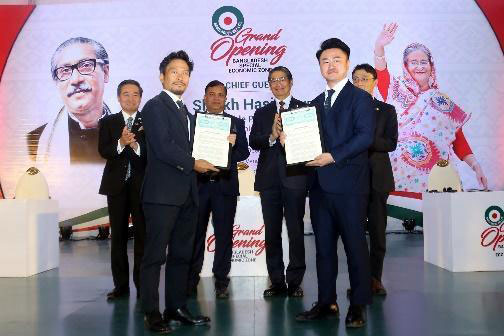
At the BSEZ opening ceremony (BSEZ Ltd. President Kawachi, front left).
Bangladesh experienced a stable high economic growth even during the COVID-19 pandemic. With a population of 170 million, it is the world's eighth most populous country with an average age of 27.6 years. Bangladesh is attracting a great deal of attention for its abundant, youthful labor force and potential as a consumer market, even in fast-growing Asia. The garment industry accounts for about 40% of Bangladesh’s industrial sector. It is maintaining its competitiveness through inexpensive personnel costs which accounts for more than 80% of the country's export earnings. However, due to Bangladesh’s rapid economic growth and expected labor cost increase in the near future, a shift in industrial structure is required.
“Diversifying industry and creating higher value through the promotion of foreign direct investment (FDI) and other measures are the most important themes of Japan’s future assistance for Bangladesh," says Mr. Ichiguchi Tomohide, Chief Representative of JICA's Bangladesh Office. Among these, JICA’s focus has mostly been given to the BSEZ, which will be Bangladesh's first industrial park fulfilling international standards. In Bangladesh where various uncertainties and risks exist, the most important factor in attracting FDI is to create a business environment in which private companies can confidently invest in the manufacturing industry.
JICA's unprecedented and comprehensive cooperation has thus been pivotal in making the BSEZ an attractive investment.
A major appeal of the BSEZ is its infrastructure development system. Industrial parks’ Infrastructure development is normally carried out all at once; however, in Bangladesh where flooding is common, a large initial investment is required just to develop the land. Therefore, public funds were used for the BSEZ to reduce the initial investment by private companies. Thanks to this, the BSEZ was developed as Bangladesh's first industrial park that meets the highest international standards, capable of withstanding the largest flood the country has seen in the past 100 years.
The Bangladeshi government is financing the infrastructure around the BSEZ (access roads to the site, etc.) and the infrastructure of the underlying property (land development for the industrial park, etc.), while BSEZ Ltd. is financing the infrastructure within the industrial park itself (access roads within the site, etc.). JICA supports the Bangladeshi government's infrastructure development financing with Japanese ODA loans, and Japanese companies have great trust in the BSEZ as it was developed through the combined efforts of the Japanese public and private sectors. President Kawachi says, "Since the opening of the park, we have received inquiries from around 40 companies, mainly from Japan, which shows great promise”.
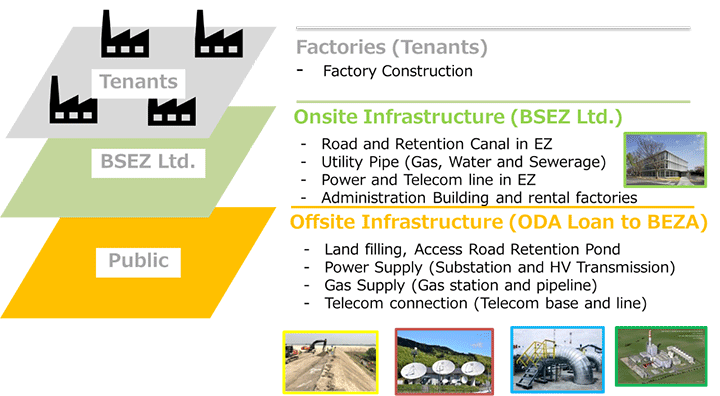
BSEZ Development System
BSEZ Ltd.’s investment structure is also unique. JICA supports BSEZ Ltd. through (1) equity back finance to the Bangladeshi government through its Japanese ODA loan program and (2) direct investment in BSEZ Ltd. through private sector investment financing. What is more, BSEZ Ltd.'s operations are backed by the Japanese and Bangladeshi governments.
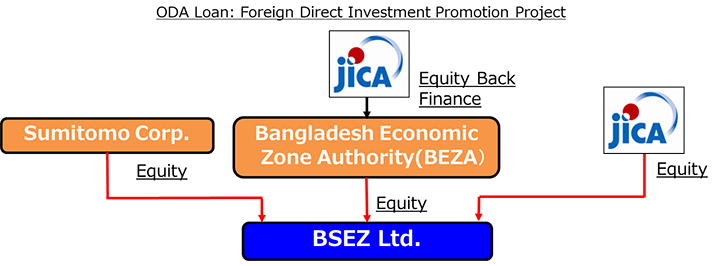
BSEZ Ownership Structure
In addition, in order to encourage companies to become tenants of the BSEZ, JICA is supporting the establishment of a one-stop service (OSS) center to simplify the complicated administrative procedures for investment permits and approvals in EZs. JICA also supports the establishment of OSS offices in the BSEZ through technical cooperation projects. Mr. Ichiguchi feels that the investment environment has steadily improved, noting that “The development of the OSS accelerated investment approvals for a pre-construction start in the SEZs. Before, it used to take six months to a year. Now, the construction can begin in about three months.” JICA also supports BSEZ tenants with low-interest loans denominated in Taka* using Japanese ODA loans, thereby encouraging Japanese companies to set up operations there. Of JICA’s many initiatives, this project is the only one that provides such multifaceted and comprehensive support: from development to operation.
*Note: Bangladeshi currency
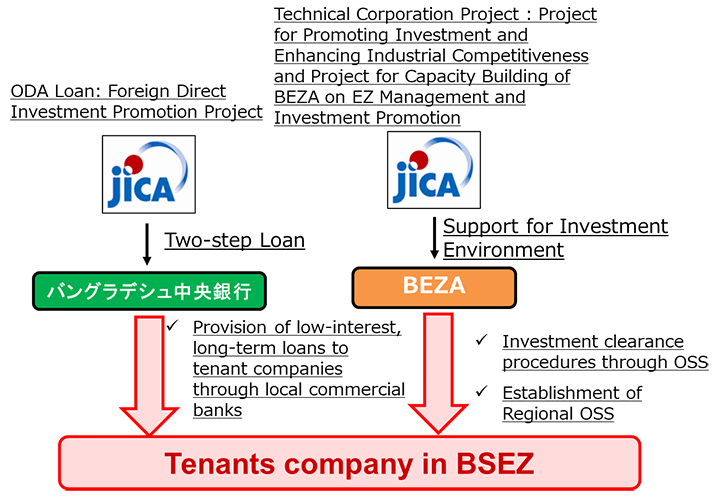
JICA’s Support for BSEZ Tenants
The Bangladeshi government envisions an ambitious industrial park plan with development of approximately 100 EZs in the country. Of them, three areas in particular are expected to meet the international standards: the BSEZ in Narayanganj, the BSMSN in Mirsharai Upazila area in northern Chittagong, and the Matarbari-Moheshkhali area in Cox’s Bazar. The Mirsharai and Matarbari areas are on the waterfront and are expected to attract heavy industries that will replace the garment industry. For this reason, they are positioned as priority areas and sectors in the Bay of Bengal Industrial Growth Belt (BIG-B) initiative mentioned at the 2014 Japan-Bangladesh Summit Meeting.
Mr. Ichiguchi says, “We expect that upstream companies in the industrial value chain will advance into the Matarbari region in the next 20 years, capitalizing on the geographical advantage of Bangladesh’s only large deep-water port.” In the Matarbari region, JICA is implementing the Matarbari Port Development Project, a Japanese ODA loan project among others with the aim of attracting investments worth one trillion yen in the future. JICA intends to engage in further cooperation, ranging from the formulation of a comprehensive development plan to support for infrastructure development in each sector, including power, energy, ports, and roads.
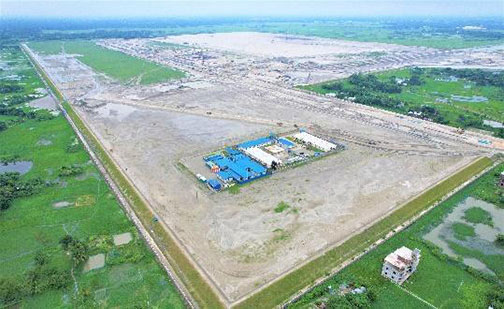
BSEZ development site.
scroll